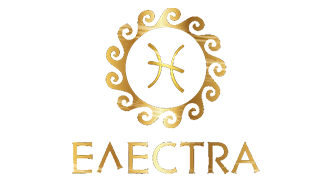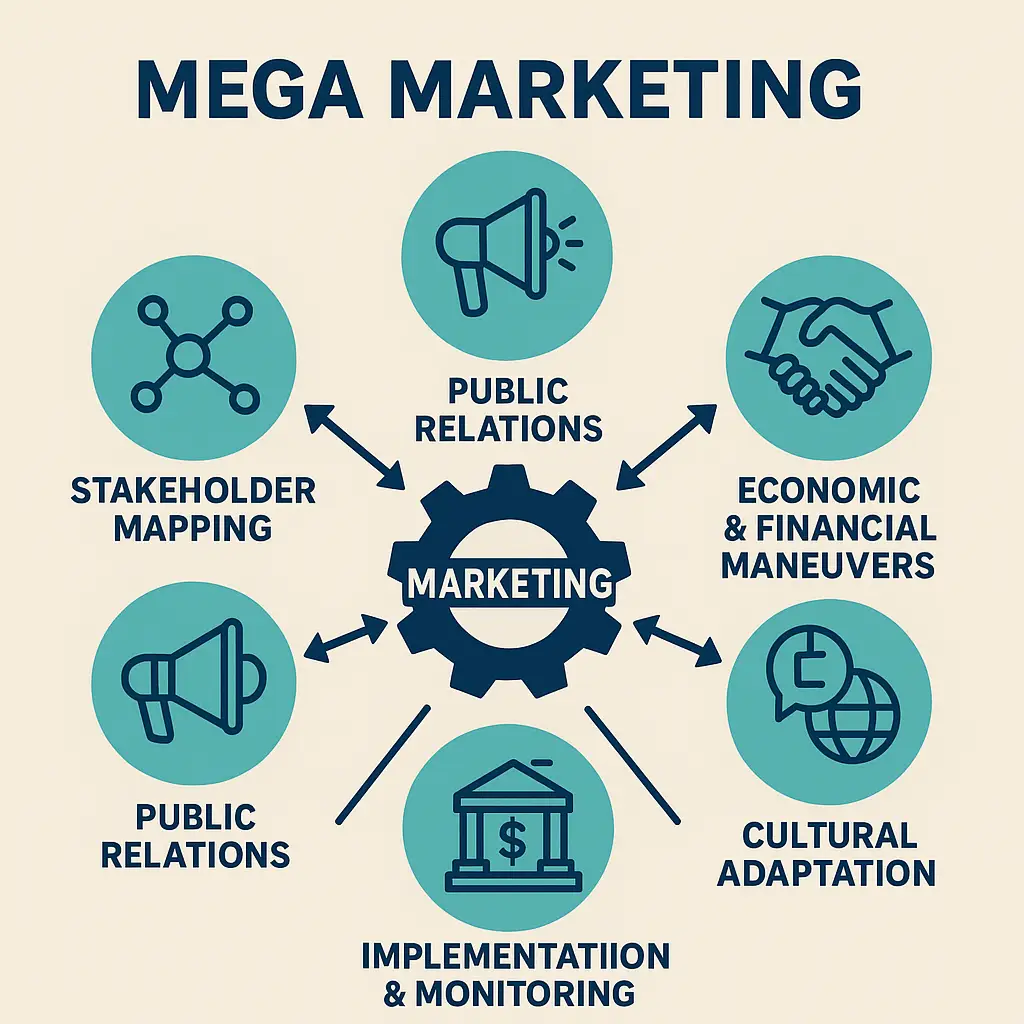Introduction
Mega Marketing expands the traditional marketing paradigm by incorporating strategies to manage and influence a firm’s external environment—governments, media, pressure groups, and other stakeholders—beyond the usual 4Ps of product, price, place, and promotion (en.wikipedia.org, hbr.org). Coined by Philip Kotler in 1986, Mega Marketing adds two additional Ps—Public Relations and Power—to navigate complex market-entry barriers and broader societal forces (en.wikipedia.org). This article explores the concept, its components, practical applications, challenges, and actionable guidance for marketers operating in high-stakes or regulated contexts.
What Is Mega Marketing?
Mega Marketing is defined as the strategically coordinated use of economic, psychological, political, and public relations skills to secure cooperation from multiple external parties in order to enter or operate in a given market (hbr.org, ukessays.com). Unlike conventional marketing, which focuses primarily on consumer demand and the marketing mix, Mega Marketing recognizes that non-market forces—legislation, public opinion, interest groups, and power structures—can decisively influence market success (mbaskool.com, masters-in-marketing.org). It typically involves higher costs, longer timeframes, and sophisticated stakeholder management to overcome barriers such as regulatory restrictions, political favoritism, cultural biases, or entrenched distribution channels.
Core Components of Mega Marketing
- Public Relations (PR) as a Marketing Lever
Effective PR goes beyond standard brand communications, aiming to cultivate goodwill among communities, media outlets, NGOs, and other stakeholders prior to or alongside market entry (en.wikipedia.org). This involves community engagement initiatives, CSR programs, media outreach, and dialogue with local opinion leaders. By proactively shaping perceptions, firms reduce resistance, gain social license to operate, and foster a supportive environment for their offerings. - Power and Influence Strategies
Power in Mega Marketing refers to the ability to persuade or incentivize third parties—government bodies, regulators, distributors, or alliance partners—to facilitate market access (en.wikipedia.org, ukessays.com). Tactics may include lobbying, forming strategic alliances, offering economic incentives (e.g., joint ventures, investment pledges), or negotiating favorable terms. These efforts require understanding local political dynamics, legal frameworks, and cultural norms to wield influence ethically and effectively. - Economic and Financial Maneuvers
Beyond pricing and promotion, Mega Marketing often entails financial commitments such as infrastructure investments, subsidy negotiations, or financing arrangements that benefit local stakeholders (bcm.marketing). Demonstrating economic value—job creation, technology transfer, or supply-chain development—can persuade authorities and communities to support entry or expansion. - Psychological and Cultural Adaptation
Navigating cultural biases and social norms is crucial. Mega Marketing demands deep cultural intelligence to tailor messaging, product adaptations, and partnership approaches that resonate locally (ukessays.com). Understanding psychological drivers and cultural sensitivities helps mitigate resistance and builds trust with non-market actors.
When to Use Mega Marketing
Mega Marketing is particularly relevant in scenarios where traditional marketing alone cannot secure market entry or sustainability:
- Regulated or Protected Markets: Industries with high regulatory scrutiny (e.g., pharmaceuticals, utilities, telecommunications) often require dialogue with regulators, compliance negotiations, and stakeholder education.
- Emerging or Developing Economies: Markets with complex bureaucracies, protectionist policies, or nascent infrastructure benefit from Mega Marketing’s emphasis on stakeholder engagement and investment pledges.
- Highly Competitive or Saturated Markets: When entrenched competitors or cartels control distribution channels, firms may need to influence policy changes or forge alliances to gain access.
- Major Product Launches with Societal Impact: Innovations that disrupt existing industries (e.g., renewable energy, biotechnology) often face public skepticism or regulatory uncertainty; Mega Marketing helps align stakeholders and build legitimacy.
Mega Marketing Process: Key Steps
- Environmental Scanning & Stakeholder Mapping
- Identify non-market actors: government agencies, regulators, community leaders, NGOs, media, and industry associations.
- Assess their interests, power, and potential impact on market objectives.
- Strategic PR and Relationship Building
- Develop a PR plan targeting key stakeholders early. Host informational sessions, participate in local events, and engage thought leaders to shape favorable narratives.
- Leverage CSR initiatives aligned with community needs to demonstrate long-term commitment.
- Power and Influence Tactics
- Craft lobbying strategies: prepare evidence-based proposals illustrating mutual benefits (e.g., economic growth, employment).
- Form alliances: partner with respected local firms or institutions to strengthen credibility and share risks.
- Negotiate incentives: explore tax breaks, joint investments, or technology-sharing agreements acceptable to both sides.
- Cultural and Psychological Alignment
- Conduct in-depth cultural audits: understand local values, taboos, and decision-making styles.
- Adapt branding, messaging, and product features to local preferences without diluting core brand identity.
- Implementation & Monitoring
- Roll out combined marketing and non-market actions in coordination, ensuring consistency in messaging and stakeholder engagement.
- Monitor regulatory developments, public sentiment, and competitor responses; be prepared to adjust tactics.
- Evaluation & Feedback Loop
- Measure outcomes not only via sales metrics but also stakeholder sentiment, regulatory milestones achieved, and reputation indices.
- Use feedback to refine both market and mega marketing strategies for ongoing operations or further expansion.
Practical Applications and Examples
- Tech Company Entering a Regulated Sector: A fintech firm aiming to launch services in a country with stringent financial regulations might engage regulators early, propose sandbox trials, partner with local banks, and run educational campaigns to build trust among policymakers and consumers (bcm.marketing).
- Consumer Goods in Emerging Markets: A multinational consumer brand may invest in local manufacturing facilities, train local suppliers, sponsor community development projects, and collaborate with government agencies on sustainability initiatives to gain market approval and loyalty (ukessays.com).
- Healthcare Innovations: A medical-device company introducing novel technology may need extensive PR to address patient safety concerns, collaborate with health authorities for trials, and provide training programs to practitioners, reflecting Mega Marketing’s multifaceted engagement (en.wikipedia.org).
Challenges and Ethical Considerations
- High Costs and Timeframes: Mega Marketing often requires significant investments—financial, human resources, and time—to manage complex negotiations and relationship-building (mbaskool.com).
- Ethical Risks: Influence tactics must avoid unethical lobbying or coercion. Transparency and adherence to local and international regulations are paramount to maintain credibility and avoid reputational damage (en.wikipedia.org).
- Balancing Local Adaptation with Global Consistency: Customizing approaches for different markets can strain resources and complicate brand management; firms must balance local responsiveness with a coherent global strategy.
- Measuring Non-Market Outcomes: Quantifying the impact of PR and political engagement is less straightforward than tracking sales, requiring development of appropriate metrics (e.g., stakeholder sentiment indices, policy achievement milestones).
Integrating Mega Marketing into Overall Strategy
- Cross-Functional Collaboration: Ensure marketing, government affairs, legal, finance, and CSR teams coordinate closely. Mega Marketing succeeds when non-market and market functions work in synergy.
- Stakeholder-Centric Planning: Incorporate stakeholder analysis into strategic planning processes, treating non-market actors as critical “customers” whose buy-in is essential.
- Scenario Planning: Develop contingencies for regulatory shifts, political changes, or public opinion swings; maintain agility to respond to evolving external conditions.
- Ethics and Compliance Framework: Establish clear guidelines for engagement with authorities and third parties to prevent unethical practices; ensure transparency in reporting interactions.
- Continuous Learning: Leverage insights from each market entry or campaign to build organizational knowledge repositories on regulatory landscapes, cultural nuances, and stakeholder engagement best practices.
Conclusion
Mega Marketing extends traditional marketing boundaries by explicitly addressing the power dynamics, public relations, and societal factors that can make or break market initiatives—especially in complex, regulated, or emerging-market scenarios. By systematically mapping stakeholders, crafting PR strategies, employing influence ethically, and aligning culturally, firms can overcome non-market barriers and achieve sustainable success. While resource-intensive, Mega Marketing’s integrated approach is indispensable for businesses pursuing challenging market-entry goals or innovations with significant societal implications.
References
- Kotler, P. “Megamarketing.” Harvard Business Review, March 1986. (hbr.org)
- “Megamarketing.” Wikipedia. (en.wikipedia.org)
- UKEssays. “Concepts of Mega Marketing.” (ukessays.com)
- MBA Skool. “What is Mega Marketing?” (mbaskool.com)
- BCM Marketing. “Megamarketing: How to apply it to your business.” (bcm.marketing)

